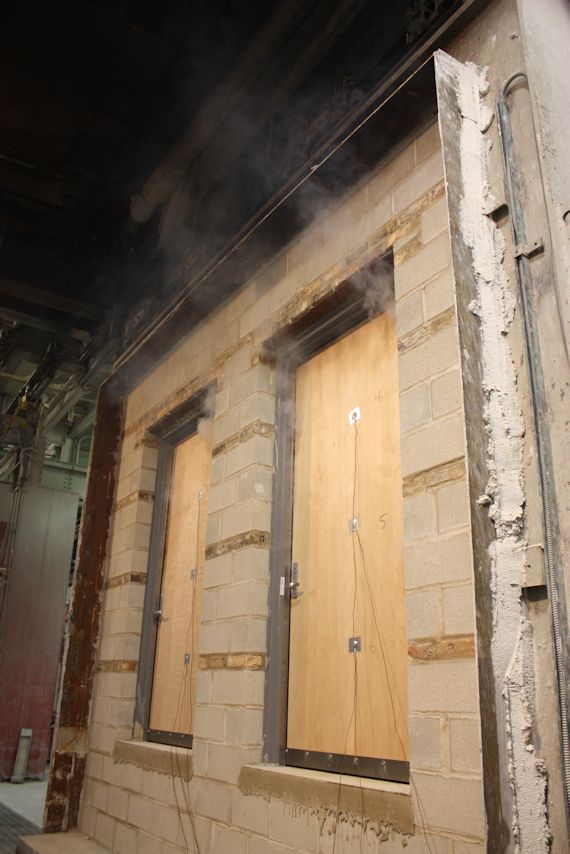 An article in the current issue of NFPA Journal addresses a problem that is well-known to those of us working with fire doors – excessive clearance. NFPA 80 limits the allowable clearance at the heads, jambs, and meeting stiles to a maximum of 3/16-inch for hollow metal doors (and for other 20-minute doors in hollow metal frames, beginning with the 2016 edition), and 1/8-inch for wood doors (with the exception of the aforementioned 20-minute doors). Clearance at the bottom of fire doors is limited to 3/4-inch. Building fluctuation can cause doors that were previously compliant to have excess clearance over time or even as the seasons change.
An article in the current issue of NFPA Journal addresses a problem that is well-known to those of us working with fire doors – excessive clearance. NFPA 80 limits the allowable clearance at the heads, jambs, and meeting stiles to a maximum of 3/16-inch for hollow metal doors (and for other 20-minute doors in hollow metal frames, beginning with the 2016 edition), and 1/8-inch for wood doors (with the exception of the aforementioned 20-minute doors). Clearance at the bottom of fire doors is limited to 3/4-inch. Building fluctuation can cause doors that were previously compliant to have excess clearance over time or even as the seasons change.
In many cases, the doors have been in place for decades, and could cost thousands of dollars to replace. A few products have been tested to address excessive clearance on fire doors, but there are limitations as to the maximum rating and clearance, and often the door material. As more jurisdictions begin to enforce the annual inspections of fire door assemblies, one of the most frequent questions I receive is how to address these clearance problems. At this point I don’t have a great answer.
I recently spoke to a fire door assembly inspector who is responsible for keeping the fire doors compliant at a state university in Massachusetts. He said that the fire marshal is enforcing the annual inspection requirements for their campus, and that the clearance problems have been discussed. Currently, the AHJ in that location is allowing clearances of up to 1/4-inch at the head, jambs, and meeting stiles, if intumescent gasketing is installed. This is basically being accepted as an equivalency, and is at the discretion of the AHJ. In some conditions the code official may require the lockset/latchset to have a 3/4-inch latch throw, to ensure positive latching despite the slightly larger clearance. I want to stress – these solutions are not authorized by NFPA 80 – they are field measures that have been acceptable to particular code officials.
The NFPA Journal article discusses an upcoming project to test the effects of clearances on fire door assemblies:
“To bring more clarity, the Fire Protection Research Foundation has begun work on a full-scale fire test on fire doors with varying gaps between the door and frame. The tests will first try to verify that the minimum gap sizes mandated for years by NFPA 80 are actually sufficient to prevent door failure—an outcome that committee members are optimistic about. Next, researchers will increase gaps on the top, bottom, and sides of the doors in different combinations to try to determine how large these gaps can be without compromising the door’s function.”
Hopefully this research will provide some other options and a little more flexibility for fire door assemblies. If not, it will at least confirm whether the existing clearances provide the needed protection. You can read the full NFPA Journal article here.
Have you experienced problems with oversized clearances?
If yes, what are some potential solutions?
You need to login or register to bookmark/favorite this content.





Lori, NGP has done testing – 1st please update the link titled Steel Stop Extender – We now have 90 MINUTES on that solution and since you MUST install the set of items we are now marketing and selling it as a complete set including all components: GAP90 or GAP90DKB. https://www.ngp.com/ngp/cache/file/3AFB8D22-37AE-4A46-B99CA89CCC05E494.pdf
Next, we failed some tests along the way with Intumescent on Fire Doors with excessive Gaps. Those “Stop Gap Measures” that a local AHJ dreams up are not based on testing or certification and should be avoided – most likely in my experience the doors will deteriorate and fail with the non-fire side of a wood door igniting well before the rating on the door. Only use truly established tested product solutions that are also Certified by the test lab for use on doors with excessive gaps or risk going up in flames.
Roger Skold, AHC
Technical Director
National Guard Products, Inc.
Thanks Roger! I updated the link. I have also seen doors with oversized gaps fail fire tests, so it will be interesting to see what the NFPA study finds.
– Lori
I know field modifications on fire rated doors are not allowed, but for example if I have a fire rated door going into a mechanical room and the gap at the bottom of the door is 1″, how can I reduce that gap without replacing an otherwise good door? We thought about adding bottom weather strips but that would be only for you not to be able to see the gap. Can a kickplate be added low enough as to reduce that gap? Thank you.
Hi Nicolas –
Adding a standard sweep or a kick plate won’t bring the door into compliance, but there are a few products linked on this post that might help: https://idighardware.com/2017/06/qq-wwyd-excessive-clearance-on-fire-doors/.
– Lori
While waiting for further study and testing, I would hope that the fire door assembly inspector at the state university in Massachusetts will get the AHJ to sign a written document that he/she will allow larger gaps than NFPA 80 requires.